Arts
Glamour on stage at Navarangahala
Unique festival for children
by Ranga Chandrarathne
|
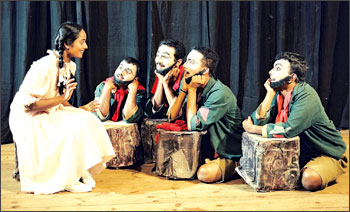
Walaspaula
|
The children's theatre Festival which was held at Navarangahala
recently, was unique on many accounts. It is, perhaps, the only drama
festival dedicated to children in Sri Lanka. The festival was made up of
two dramas; Himakumariya and Walaspaula.
The dramas were adaptations of Snow White and the Three Bears and
suited for the intended children's audience. The overall success of the
festival was manifested not only in terms of the well-trained children
who took part in the dramas but also the large audience which filled up
the Navarangahala.
Himakumariya and Walaspaula were written by veteran theatre
personality Somalatha Subasinghe and were based on fairy tales.
Somalatha herself directed Himakumariya while Walaspaula was directed by
Dr. Chandana Aluthge. The significant aspect of Walaspaula is that it
was intended not only to entertain the children but also to enhance
their language skills through the instrument of drama. It is no doubt
that drama is the most appropriate educational instrument to impart
children with necessary language skills.
It is obvious that the negative trend of deteriorating standards in
languages should be arrested in order to march ahead as a nation. For
this matter, perhaps, the most appropriate stage at which a firm
foundation of language skills can be laid is at one's childhood. Here at
the festival intrinsic properties of drama has been exploited to the
maximum to achieve that end.
|
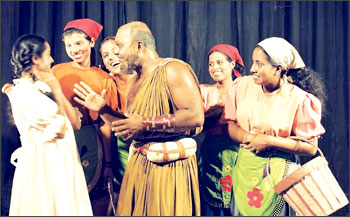
Himakumariya |
Walaspaula was marked for its economy of dramatic situations.
However, the most common feature of the text of the drama was that it
contained rhythmic dialogues and songs which would have been a daunting
task to translate it into aesthetically satisfying drama, especially
aimed at children's audience. In order to overcome these challenges, it
seemed that directors have exploited the intrinsic properties of songs
and the well-defined movements on the stage. Distinctly songs appeal to
the children's audience which was manifested by the high degree of
attention the children paid to the dramas from the very commencement to
the end.
However, Himakumariya which has all the ingredients of a
fully-fledged drama has been produced in an entirely different style to
that of Walaspaula. Through the productions the directors also attempted
at creating awareness in children of appreciating music, diverse colours
and rhythmic movements. The dramas are designed to instill in children
an idea about the human relationships and hierarchical order in a
family; from father, mother, and brothers and to sisters. It should be
mentioned here that music scores used for the dramas were drawn from a
classical base in a manner representing diverse traditions of music in
Sri Lanka. If the intention of the directors was to introduce
qualitative music and Sri Lankan dance forms and culture to the
children's audience, it would be successful as the music and dancing
forms were well-integrated into the dramas so that they will register in
the subconscious of children. As children tend to recall the tunes and
dancing forms with the stories of Himakumariya and Walaspaula. This is,
indeed, one of the effective methods in training children to taste
qualitative music and dance forms. Somalatha Subasinghe, Dr. Chandana
Aluthge and Lanka Children and Youth Theatre Foundation (LCYTF) which
was established by Parliamentary Act of 3 of 2007, should be commended
for using drama as an effective tool of education, especially, in the
most appealing manner.
Tharupathy Munasinghe composed music for Walaspuala while music for
Himakumariya was by M.R. Chulasinghe. Tharupathy is a young talented
musician and M.R. Chulasinghe is a matured music director who amassed
wealth of experience in composing music for children's drama. Though
children theatre is an effective tool of inculcating Sri Lankan values
and culture in children, Government's attention has not adequately been
paid to this vital sector. Though the music for Walaspaula is different
in presentation to the music for Himakumariya, the music is based on
traditional tones.
However, traditional tones have been fused with modern sounds and
rhymes in Walaspaula. Music for Himakumariya is composed based on
classical tradition and the director has tried to use diverse styles of
music. For instance, for the dwarfs, Baila music form has been used as
they tend to be ordinary folks. Baila, though considered as mean
tradition of music, was originated from the flamingo tradition of music.
It can also considered as one of the modern folk music traditions
such as Jazz, rock and Blues . Most of the instances in Walaspaula,
music, rhythmic movements, colours and light have been used to put
across ideas and concepts. This would have been a novel experience for
children. One of the objectives of the directors is to make understand
the children of society and day-to-day problems. These challenges are
depicted in a symbolic manner through a subtle manipulation of
characters and incidents in addition to exploiting properties of music,
colours and movements on the stage.
It should be mentioned here that if not for the generous sponsorship
of HNB Assurance, the organizers would not be able to bring the price of
the tickets to an affordable level so as to ensure maximum participation
of children for the festival.
Together for all
by Anushka Nanayakkara and Sajitha Prematunge
People and military personnel die so often these days that we tend to
forget them eventually after the initial shock. But we realized one
thing after we got back from Trincomalee on an assignment to cover the
Navy Dockyard: the deaths of any military personnel hit us both very
hard. Forgive me if you think that we are being a little melodramatic,
but this is true. We experienced first hand what it meant to be a
soldier, in the true sense of the word. What they had to go through from
the day they joined the forces.
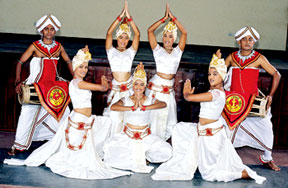 Our country has acquired many great victories at the battle front
last year against the terrorists. Still with all these victories, our
young military heroes; sons of Mother Lanka shed their blood to
safeguard all four communities Sinhala, Tamil, Muslim and Burgher. Even
terrorists have been less reluctant to surrender, as the Sri Lanka Navy
is known to be one of the most respected and law abiding forces in the
world. The Sri Lanka Navy is also known as the first line defence in our
country. It is our duty to make the dreams of these heroes and their
families' come true. Our country has acquired many great victories at the battle front
last year against the terrorists. Still with all these victories, our
young military heroes; sons of Mother Lanka shed their blood to
safeguard all four communities Sinhala, Tamil, Muslim and Burgher. Even
terrorists have been less reluctant to surrender, as the Sri Lanka Navy
is known to be one of the most respected and law abiding forces in the
world. The Sri Lanka Navy is also known as the first line defence in our
country. It is our duty to make the dreams of these heroes and their
families' come true.
The silent force of the three forces - Navy is renowned for their
discipline and tough training. But that's not all they are devoted to.
There are approximately 40,000 in the Navy cadre and the Naval Welfare
Society not only cares for their personnel but also the living relatives
of the war heroes who have sacrificed their lives in the line of duty.
The Sri Lanka Navy; Sevavanitha Unit once again has taken a giant
step as in the year 2006, by organizing a musical bonanza under the
theme of 'Rata wata bandi ran weta'(Golden fence around the country).
The first step of the project - building 48 houses and completing
other existing incomplete houses of war heroes - is already over. The
main focus here was the relatives of the soldiers who lost their lives
in battle. The second step, soon to be initiated, is to build 45 modern
houses for disabled soldiers and relatives of war heroes who lost their
lives in the battle. The required land will also be provided by the Navy
and is to be situated in Kalutara.
Sri Lanka Navy understands the need of supporting the sailors and
officers, families who have been killed in action, A musical evening, of
which the profits will be donated for the building of houses, is
scheduled to take place at the BMICH auditorium on January 13.
The evening will be filled with music provided by famous artists Like
Latha Walpola, Indrani Perera, Rajiv Sebestian, Sunil Perera, Kasun
Kalhara and Centigradez backed by the "cultural, western and naval
programme band". More glamour will be added by the performances of the
dancing troupe of the Sri Lanka Navy.
It's time for us to hold hands, to strengthen the golden fence by
being together for all. Experience an evening with a star studded
line-up of artists, together with our heroes.
[email protected]
Understanding complex grammar of choreography
Depends on one's intellectual capacity
 Of classical Art, Ravi Bandu states that the ideas and concepts
cannot be turned into a set of movements as in the exact manner. Some
artists stated that they could not understand pieces of choreography in
Nirmana ballet. It is either because they could not understand the
concept behind the complex choreography or they could not understand
both concept and the choreography. Of classical Art, Ravi Bandu states that the ideas and concepts
cannot be turned into a set of movements as in the exact manner. Some
artists stated that they could not understand pieces of choreography in
Nirmana ballet. It is either because they could not understand the
concept behind the complex choreography or they could not understand
both concept and the choreography.
|

Ravibandu Vidyapathy- Dancer, choreographer, percussionist and
painter
|
Watching a dance is similar to listening to a symphony. Though the
symphony is based on a deep philosophical idea, it may not convey the
idea in the exact manner. For instance, Pradeep Ratnayake's composition
"Wind" consists of diverse scores of music from equally diverse sources.
Here Pradeep has recreated an idea of wind and its velocity. What
Ravibandu did in Nirmana is to create choreographs based on ideas and
poems. According to Ravibandu, dancing is an abstract medium and not an
exact art. So the language of movements is not a universal language
which can be understood by diverse personalities in the exact manner. It
is experienced by different audiences in different ways. Understanding
or not understanding a complex grammar of choreography is a question of
one's intelligence and power of comprehension.
Perhaps, the choreographies in Nirmana may not be in conformity with
conventional understanding and deep-rooted concepts on the part of some
persons who said that they could not understand it. It is not necessary
for each and every one to understand the complex grammar of
choreography. However, everyone can enjoy choreography as a piece of
beauty of movements under pleasant lighting with designed costumes
against a properly made set.
For instance, a Vannama or up country classical dance has apparently
no meaning. However, if a segment of Kohobakankariya, Yakannuma is
condensed into a seven minute item of dance, the audience appreciates it
on its artistic merit in terms of movements, combination of dance with
the drum. So people do not ask about the origin of Yakannuma.
|
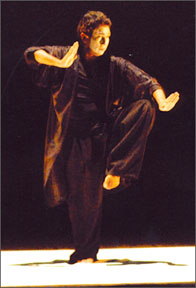
Performance on white carpet- finest example of conplexities in
genuine and original art |
One's understanding of art differs from one medium to another and on
diverse plains. For instance, literature, one may understand the
superficial storyline without understanding the sub-text and idioms and
metaphor and another many understand the storyline as well as symbolism
encrypted in the story. This is same with music and even with painting.
An artist wants to depict a woman in a melancholy mood. However, one may
only see a beautiful woman without understanding the deep meaning behind
the brush strokes. This characteristic can be seen in every media on
different plains.
Especially in a medium like dance, a beauty of the body and movement,
one may not necessarily understand the sub-text to appreciate a piece of
dance. Ravibandu refuses the notion that there is no interest for
serious art in the country. He attributed lack of interest in serious
art to lack of exposure to serious art especially the provincial
audience. As one who is used to listening to Jazz, may not, at once,
like listening North Indian classical music.
However, he/she may develop an interest if they listen to classical
music regularly. Due to the influence of various social, economic
factors, the habit of watching dance performances has been diminished.
Unlike in 60s and 70s, drama and dance performances do not circuit
around the country but more or less are confined to Colombo.
Though not perfect as in Japan, in school syllabi, for instance,
dance has been designed to train students to appreciate classical dance.
Though the classical ballet has been introduced in the school curricula,
there are practical constraints to realise the goals set out in the
curricula. Teaching materials have not been provided for teachers of
dancing. For instance, there is a lesson on Swan Lake, a Western ballet.
However, at least, five percent of teachers have not watched even a
video of Swan Lake. So the sources for appreciating drama have not been
provided. There should be a system of training children to appreciate
serious art.
Commenting on possible prone out of practical aspect from aesthetic
subjects, Ravibandu stated that aesthetic subjects produce a sensitive
person. This will affect the students' level of appreciation. The move
to prone literature and history had a negative effect on the personality
development of generation of students. However, now these subjects have
been re-introduced, at least, as optional subjects. The first step
towards realizing the objectives of aesthetic subjects should be to
re-design the syllabi so as to train students to appreciate serious art.
As an artist who engaged in creating fusion music, he is of the view
that Sri Lankan audience like fusion music. However, fusion music should
not be compared with classical music or any other tradition of music. In
a fusion music composition, a musician borrows compatible element from
diverse forms of music and put them together in an aesthetically
satisfying manner. It is a good medium of music.
There are musicians who are equally well versed in classical music as
well as in fusion music. There are others like Preme Joshua who are not
well versed in either classical music or fusion music but compose pieces
of fusion music. However, those pieces are superficial. Ravibandu
rejects the notion that those musicians engaged in composing fusion
music are immature.
An important component in a concert is to strike a balance between
fusion music and classical music. One should also practice classical art
in the same way he/she practices fusion music.
Ravibandu hails from a lineage of artistes, his father being
Somabandu Vidyapathy, mother Malathi was also dancer. Ravibandu's
maternal grandfather was Master Algama Kiriganitha. His paternal legacy
peopled with talented dancers and temple painters. Before formerly being
inducted into dancing Ravibandu had been pursuing paintings. He joined
Chitrasena-Vajira dancing school which had been a turning point in his
life. He was so engrossed in dancing that he eventually ended up being a
professional dancer.
Ravibandu gratefully refers to Chitrasena, Vajira and his father as
three key personalities who made him a professional dancer. During his
studies at the Chitrasena-Vajira dancing school, he met pioneers in the
field of art; Dr. Lester James Peiris, Amaradeva, Lionel Algama, Henry
Jayasena, maestro Premasiri Khemadasa.
He is also greatly influenced by his father who was well versed in
Western classics. So Ravibandu's works bear testimony to his extensive
exposure to Western classical literature, Shakespearean drama and Greek
mythology. For a short stint, Ravibandu studied history of Arts under
the tutelage of Dr. Salaman Fonseka. Dr.Salaman Fonseka was also
instrumental in creating an abiding interest of Western classical music
in Ravibandu though he had already used to listening classical music.
One of his areas of talent is drums. He not only learnt classical
Kandyan drums but also traditions like Khwaj.
He is fond of making creations based on classical tradition. He is
greatly influenced by the traditions of Kandyan and Khathakali dancing.
He studied Khathakali dance at Kerala Kalamandalam. Among his
cerebrated creations are Hecubi, Ghandari and Kusumalatha, an anti-war
ballet, Judas, a creation based on biblical story of betrayal of Jesus,
are highly appreciated by deserving audience around the world.
In creating 'Judas', he was influenced by the dancing style of
Chithrasena and the powerful images of Laurence Olivier. Ravibnadu is
currently the Artistic Director of State Dance Ensemble. In addition he
is also the Director of Ravibandu-Samanthi Dance Ensemble.
Aang Devpura
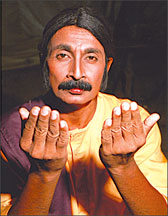 Aang Devpura, a satire will go onboard at Lumbini theatre on January
13, 2008 to commemorate Jagath Muthukumarana's thirty years career in
the field of art. Muthukumarana commenced his career as a member of Dr.
Gamini Hattotuwegama's street drama troupe. Aang Devpura, a satire will go onboard at Lumbini theatre on January
13, 2008 to commemorate Jagath Muthukumarana's thirty years career in
the field of art. Muthukumarana commenced his career as a member of Dr.
Gamini Hattotuwegama's street drama troupe.
The drama is woven around a story where an elephant is ravaging the
cultivations in a village. The self-centered village headman turns a
blind eye on the rampaging elephant and at last, he prays for the god to
intervene in the matter. Though the God appears, it turns out that the
God himself is the elephant and village headman in an agreement with the
god, did not take any step to shoot the elephant despite the damage it
causes to the cultivations.
As promised by the god, the village headman is sent to heaven while
god who is craving for fleshly desires assuming the role of the village
headman and faces numerous troubles during his stay on earth. The drama
ends with a hilarious note when villagers who followed the village
headman to heaven ended up being dumped into the village tank. They
bathed in mud imagining that it is legendary Anottata Lake in heaven.(RC)
A Pilgrim to the Buddhist Himalayas at Galle Fort
Exhibition of Panoramic Photography by Jaroslav Poncar, University of
Cologne, Germany organized by the Goethe-Institut Sri Lanka in
collaboration with KODAK & ACME Colombo will be held at the Old Dutch
Warehouse, Hospital Road, Fort Galle from January 16 to 20.
The exhibition is coincided with the Galle Literary Festival which is
being held in Galle. The Exhibition is opened from 8.00 a.m. to 6.00
a.m.
Jaroslav Poncar born 1945 in Prague, has lived in Cologne since 1973
where he is a professor at Fachhochschule Kln (University of Applied
Sciences Cologne).
His photographic projects took him to Africa, Arabia and to Asia,
especially to the Himalayas, Ladakh, Bhutan, Nepal, Tibet, Mustang,
India and Cambodia.
In 1976 he took for the first time a panoramic camera to the Western
Himalayas - the antique Russian FT-2 - and since that time he
specialized on panoramic photography.
He is the author of 19 splendid books with panoramic photography and
of 11 documentary films on the same regions and particularly Buddhist
cultural heritage. It is for the first time that Jaro Poncar came to Sri
Lanka to inaugurate his exhibition and to go on a research trip in
December 2007. But it wouldn't be the last time, as he said.
The exhibition "A Pilgrim to the Buddhist Himalayas" was compiled on
the request of the Goethe-Institut Sri Lanka, German Cultural Centre in
Colombo and shown under the auspices of the 50th anniversary of this
cultural institute at the Harold Peiris Gallery (Lionel Wendt) in
December 2007. All photographs were printed by KODAK at the photographic
laboratory ACME. It is for the first time that Mr. Poncar has accepted
to do prints of his work outside Germany - to his full satisfaction. The
exhibition consists of 28 photographs including 4 panoramic views of 50
x 200 cm and 4 panoramic views of 80 x 320 cm.
Kala Pola on January 20
Sri Lanka's most popular open-air art gallery cum art fair, 'Kala
pola' will he held at the lush exhibition ground of Viharamahadevi Park
on the 20th January, 2008. This year's Kala Pola will feature over 300
artists and sculptors and their works. Kala Pola is modelled on Summer
Art fairs in European capitals. For the 15th consecutive year, 'Kala
Pola' is sponsored by the George Keyt Foundation. (RC) |
